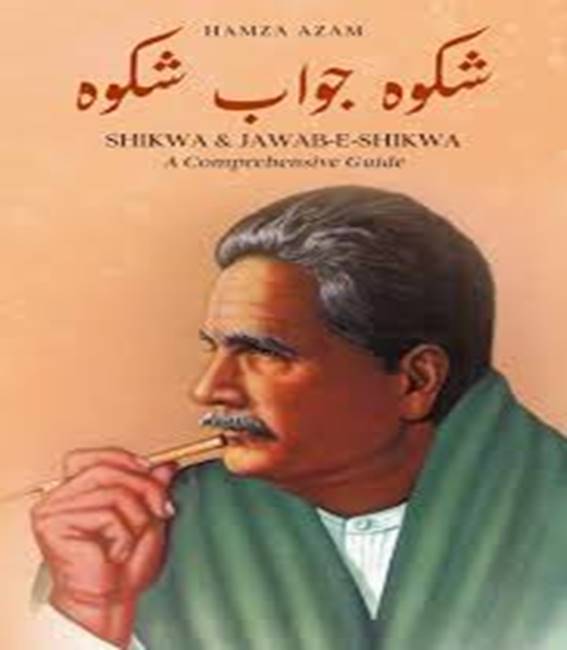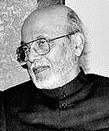
To follow Prophet Muhammed (pbuh) is to strive for human perfection until one becomes a mirror for heavenly attributes and worthy of Divine love. This is the message ofShikwa, Jawab e Shikwaand of Iqbal’s masterpiece, BaNg e Dara. Perfection of character, in the prototype of the innate character of Prophet Muhammed (pbuh), is the clarion call of Iqbal to Muslims - Image Amazon.com
A Comment on Shikwa and Jawab e Shikwa of Allama Iqbal (Part 6 of 6)
By Dr Nazeer Ahmed
Concord, CA

Ki Muhammed Se Wafa Tu Ne To Hum Terey HaiN
Ye JehaN Cheez Hai Kya Luh wa Qalam Tere HaiN (Jawab e Shikwa)
If you are faithful to Muhammed, We are yours,
Why speak of this world, the Preserved Tablet and the Exalted Pen are yours.
Iqbal’s Shikwa and Jawab e Shikwa are a clarion call to Muslims to strive for human perfection through the love of God (Ishq e haqeeqi) and fidelity to Prophet Muhammed (Meethaq e Risalat).
How does fidelity to Prophet Muhammed (pbuh) lead to the love of Allah? How does it reach the Preserved Tablet and the Exalted Pen? The answers are in the Qur’an (“If you love Allah, follow me”). The Sufis have elaborated on these ideas and have constructed a cosmology that is at once aesthetically pleasing and emotionally satisfying. Iqbal derives his inspiration from these concepts.
Allah has called the Prophet “Noor” (Light) and also “Bashar” (human). For a Muslim, it is essential to accept both aspects, Noori as well as Bashari. The Prophet is Noor (heavenly Light) with all the particulars of Noor and he is human with all the requirements of being human. One aspect of the Prophet is “Nooriat” (the attribute of heavenly Light) and the other aspect is Bashriat (humanness). Both are true. There is concomitance but no contradiction between these two. To accept the one and reject the other is to reject the injunctions of the Qur’an. Here is what the Qur’an says with clarity about “Nooriat”:
Behold! There has come down a Light from Allah and a perspicuous Book (Al Ma’eda, 5:15).
And here is the clarity in the Qur’an about “Bashriat” (humanness of the Prophet):
Indeed, I am but a human like you (Al Kahf, 18:110).
In his summation of Jawab e Shikwa, Iqbal draws upon Sufi constructs on Noor e Muhammadi (the Light of Muhammed), which is the Light of Existence. Here is his eloquent affirmation:
Ho Na Yeh Phool To Bulbul Ka Tarannum Bhi Na Ho
Chamane Dhr MaiN KalyoN ka Tabassum Bhi Na Ho
Yeh Na Saqi Ho Phir Mai Bhi Na Ho, Khum Bhi Na Ho
Bazm e Tawheed Bhi Duniya MaiN Na Ho Tum Bhi Na Ho
Kheema Aflaq Ka Ustada Isee Nam Se Hai
Nabz e Hastee Tapash Amada Isee Nam Se Hai (Iqbal)
Our Translation:
If it were not for this flower, the melody of the nightingale would not be,
In the garden of eternity, the smile of buds would not be.
If there is no bearer of the cup, no wine would there be, and not the ecstasy,
In this world, the assembly of Tawhid would not be, neither would you be.
The canopy of the heavens is held aloft by this very name,
The pulse of existence accepts its energy from this very name. (Iqbal)
To understand Iqbal, one needs to take a dive into Tasawwuf. The oceans of Tasawwuf are deep and the possibility of misunderstanding always lurks in the background. Hazrath Ali (r) said: “Speak to people at their level of understanding; else you may foster unbelief”.
A good place to start is a Hadith e Qudsi often cited in select Sufi circles: “Kuntu Kunzan Maghfiya. Fa Ahbabtu An A’rafa. Fa Khalakhtu Khalqa” (I was a hidden treasure. I loved that I be recognized. Therefore, I created a creation that would know Me). That creation was al Insan ul Kamil (the perfect human), a reference to Prophet Muhammed (pbuh). All of creation is subject to the perfect human (“Wa saqqara lakum ma fis samawati wal ard – The Qur’an) (Translation: And I have made subject to you all that is in the heavens and the earth). The haqeeqat or Reality of the Perfect Human is Noor e Muhammadi (the Light of Muhammad). The term Noor e Muhammadi is Ilmiya, meaning, it is used for the transmission of Irfan or inner spiritual knowledge; it has no connotation of materiality.
What is the martaba (rank) or maqam (station) of Noor e Muhammadi in the schema of Allah’s creation? We present here a cosmology developed by the great Master, Shaik ul Azam ibn al Arabi (d 1240). It helps us explain the station of Noor e Muhammadi in the schema of God’s creation and throws some light on Iqbal’s vision as articulated in Jawab e Shikwa. Central to the narrative is the idea of Allah’s Grace and Loe, its descent and its connection with human existence.
The First Descent: The Pristine Reality (Martab e Oola):
The journey begins with the existence of one supreme Reality, known as Huwiyet or Essence, which predates all creation. This Reality existed in a state beyond comprehension, without any physical or conceptual attributes and was entirely self-contained.
The Essence was devoid of names, attributes, or relational existence. It was beyond the dualities of existence and non-existence, hidden or manifest. Sufi scholars describe this stage as a pure, undifferentiated state where language fails to capture the Divine Essence.
At this level, the cosmos did not exist in any form. The Essence was singular and independent and even the notion of the Creator and the created was absent.
The Second Descent: Wahdat (Unicity):
In this stage, the Essence begins to take on attributes and is referred to as Wahdat or Unicity. The Divine Essence becomes aware of itself, and through this self-awareness, the Names and Attributes of God are manifest.
At this descent, Existence (Wujud), Knowledge (Ilm), Light (Noor), and Witness (Shuhood), emerge as manifestations of the Essence. The Divine Names like As-Samee (All-Hearing) and Al-Qadir (All-Powerful) are introduced, emphasizing the interconnectedness of God’s attributes.
This stage also explains how the Essence and its attributes coexist without separation. Despite the apparent multiplicity of divine Names and Attributes, they remain unified in their origin. Sufi teachings stress that the differentiation between divine attributes exists only conceptually, as the underlying Reality is always one.
This is also the martaba (rank) of the Reality of Noor e Muhammadi. It means, at this station, all creation from eternity to eternity, independent of space-time and qualifications, came into the omniscient Mansha (vision) of Allah.
The Third Descent: The World of Angels (A’lam e Arwah):
The third descent introduces the world of angels, known as A’lam e Arwah or the World of the Spirit. Ibn al Arabi describes that the Universal Intellect (Aql e Kul) and the Universal Soul (Nafs e Kul) are created at this stage.
The Universal Intellect is symbolized by the Exalted Pen and the Universal Soul is represented by the Preserved Tablet, both of which play vital roles in recording divine decrees.
The Fourth Descent: A’lam e Mithal (The Domain of Prototypes):
A’lam e Mithal, or the World of Prototypes, is a subtle realm that serves as a bridge between the spiritual and material worlds. This domain is where abstract forms and archetypes exist, influencing the physical realm.
The Fifth Descent: A’lam e Ajsam (The World of Physical Entities):
The physical world, known as A’lam e Ajsam, encompasses both celestial and terrestrial entities. Higher structures include the Divine Throne (Arsh), the heavens, the stars and the planets. Lower structures consist of the material bodies of plants, animals, and humans.
The universe is sustained by Divine Grace, which permeates all existence, manifesting in both mercy and judgment. Even divine wrath, when experienced, has an underlying element of mercy, akin to the pain of a healing wound or the purification of gold.
The Sixth Descent: Insan (The Human Being):
The human being, or Insan, represents the final and most significant descent of Divine Grace. Humans are unique creations, embodying both divine and earthly attributes. They serve as khalifa or regents on earth, tasked with reflecting God’s Names and Attributes and maintaining justice and balance. In their pristine prototypes, humans have superiority over the angels as demonstrated by Adam’s knowledge of the divine Names. The prostration of the angels before Adam signifies humanity’s unique spiritual rank, while Iblis’s refusal and subsequent fall highlight the consequences of pride and rebellion.
Humans have the capacity to become “Insan e Kamil” (Perfect Humans) when they embody Divine unity and resist the influence of evil. The struggle between the angelic and satanic influences within each person defines his spiritual journey, whose ultimate goal is the achievement of Divine guidance and forgiveness.
Muhammed (pbuh) was Insan e Kamil (Perfect Human). He was a Messenger of God and the Seal of the Prophets. As Bashar, he embodied heavenly perfections.
Noor e Muhammadi is the light of existence. Allah created the heavens and the earth for Insan e Kamil and He created Insan e Kamil for Himself. The Insan e Kamil, as His a’bd (servant) and khalifa (deputy) on earth, serves God’s purpose to sort out the good from the evil and manifest al Haq, the Truth,
To follow Prophet Muhammed (pbuh) is to strive for human perfection until one becomes a mirror for heavenly attributes and worthy of Divine love. This is the message of Shikwa, Jawab e Shikwa and of Iqbal’s masterpiece, BaNg e Dara. Perfection of character, in the prototype of the innate character of Prophet Muhammed (pbuh), is the clarion call of Iqbal to Muslims.
( The author is Director, World Organization for Resource Development and Education, Washington, DC; Director, American Institute of Islamic History and Culture, CA; Member, State Knowledge Commission, Bangalore; and Chairman, Delixus Group)

